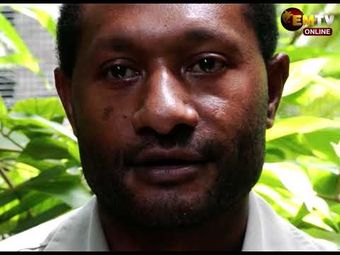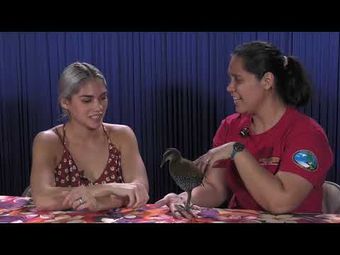Kaŋgam ‘Bird of paradise’
- Description:
- This string figure is sometimes called kaŋgam ‘Lesser Bird of Paradise’ (Paradisaea minor) and sometimes kaŋganam, most likely ‘Twelve-wired Bird of Paradise’ (Seleucidis melanoleuca) whose female is called oloŋ. They are the most common bird-of-paradise species living in Awiakay forests, both featuring either prominent tail plumage (kaŋgam), or a conspicuous tail dance (kaŋganam). This is an important feature of this string figure, in which a second string is used only to represent the tail. Along with the hornbill (in Awiakay land this is Blyth’s Hornbill (Rhyticeros plicatus), called kyakwi, or in Tok Pisin kokomo), the bird of paradise is one of the most important birds in Awiakay mythology. It is in most cases anthropomorphised, appearing as one of the main characters in several myths. One of the myths explains where the bird of paradise got his beautiful plumage. He used to be a ‘dull-looking’ bird until one day when he went to wash with an embay ‘the Greater Black Coucal’ (Centropus menbeki). They both took off their ‘grass skirts’ before jumping in the river, but the bird of paradise quickly went out, saying he needs to go for a poo. He took away with embay’s ‘grass skirt’ and is now dancing in it, while the poor embay keeps walking around, crying for his beautiful plumage. That is why his eyes are all red. For the Awiakay, the movement of the grass-skirts in dancing has always been associated with bird-of paradise tail feathers and courting displays. The dancers need to make very particular swaying motions in order to make their grass-skirts move in a way that is considered particularly sexually attractive. The same holds true for bird of paradise feathers: they are highly valued decorations, sometimes stuck into the armbands and sometimes into head dresses. Their movement, too, contributes to the sexual appeal of a dancer (either male or female). When not in use, bird-of-paradise feathers are kept in hollowed-out bamboo pipes and stuck under the roof, out of reach of children. Bird of paradise feathers themselves, or any decorations made from them are a valuable gift. Two strings should be used for making this string figure, one comes to represent the tail, the other one the body of the bird. When the design is finished, the maker moves it, so that the strings representing the tail feathers dance. Images: 02: ‘bird of paradise’ final design 03: Darja Munbaŋgoapik showing the final design of ‘bird of paradise’ . Language as given: Awiakay. You can access this item at the PARADISEC website. You will need to sign up or sign in first.
- Format:
- MovingImage
- Collections:
- PARADISEC Catalog
- Contributors:
- Darja Hoenigman
- Content partner:
- PARADISEC
- Availability:
- Not specified
-
Copyright status: All rights reservedFind out more about what you are able to do with this itemThis item is all rights reserved, with means you'll have to get permission from PARADISEC before using it. For more information, please see our use and reuse page.More informationPARADISEC has this to say about the rights status of this item:
Open (subject to agreeing to PDSC access conditions)
What can I do with this item?Non-infringing useNZ copyright law does not prevent every use of a copyright work, and this item may be hosted by an international institute or organisation. You should consider what you can and cannot do with a copyright work.No sharingYou may not copy and/or share this item with others without further permission. This includes posting it on your blog, using it in a presentation, or any other public use.No modifyingYou are not allowed to adapt or remix this item into any other works.No commercial useYou may not use this item commercially.
Welcome and warm Pasifik greetings
The information on this site has been gathered from our content partners.
The names, terms, and labels that we present on the site may contain images or voices of deceased persons and may also reflect the bias, norms, and perspective of the period of time in which they were created. We accept that these may not be appropriate today.
If you have any concerns or questions about an item, please contact us.


